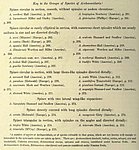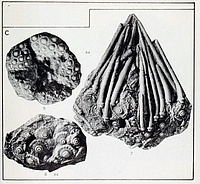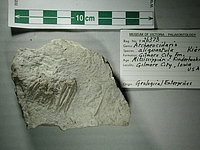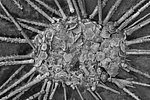Archaeocidaridae
McCoy, 1849, p.253
the ICZN opinion reference under which each name has been placed on the official list or index is given at the end of each entry.
affected entries :
|
- ARCHAEOCIDARIDAE McCoy, 1849, Ann. Mag. nat. Hist., (2)3: 253 (type genus: Archaeocidaris McCoy, 1844) (Echinoidea). Direction 41 disponible- Archaeocidaris McCoy, 1844, Syn. Char. Carb. Limest. Foss. Ireland: 173 (retained under full authority) (genus : female) (type species, by monotypy : Cidaris urii Fleming, 1828, Hist. brit. Anim.: 478) (Echinoidea). Op. 370 disponible. |
Genre type : confer supra
Description succincte de la famille : lanterne de grande taille souvent conservée. zones ambulacraires étroites. Pores de petite taille, identiques disposés de manière unisériée. Interambulacres avec 4 colonnes de plaques. Les plaques hexagonales composant les interambulacres sont nombreuses. Elles portent un grand tubercule primaire perforé dans une aréole large occupant presque toute la plaque.

|
Archaeocidaris. Agass. Gen. Ch. - Interambulacra composed of three or more rows of plates, those on each side, next the ambulacra, pentagonal, those of the intermediate rows hexagonal, as in Palaechinus ; each plate having in the centre one large, perforated tubercle, surrounded by an elevated ring, as in Cidaris, each of which tubercles bears a large, mobile, generally muricated spine. It is a singular circumstance that, except Professor Agassiz, every author who has hitherto treated of the Echinodermata of the mountain limestone, should have referred the hexagonal plates with the above characters to the genus Cidaris, when a glance at the recent or Oolitic Cidarites, would be sufficient to shew that in their entire framework there is not one hexagonal plate, both the ambulacra and interambulacra being composed each of two rows of pentagonal plates only, while in the present genus, as in Palaechinus, thein interambulacra must have been composed of more than two rows, as is obsious from their hexagonal form : the large, perforated tubercle, however, is precisely in |
accordance with that of the true Cidaris, as is also the mode of attachment and general character of the large spines with which both genera are armed. Thus, as we have seen, the Echini of the mountain limestone to differ remarkably as a group from the Cainozoic and Mesozoic genera, in the complexity of their interambulacra ; so do we find the Cidarites of the Palaeozoic rocks to differ in the same character, both from the recent and newer fossil forms : while the relartion which the recent Cidarites bear to the recent Echini is precisely equivalent to that which Echinocrinus holds to Palaechinus. I had long ago distinguished this genus in my MSS. under the name of Archaeocidaris, subsequently Professor Agassiz announced his intention of forming the genus Echinocrinus for the Cidaris Nerii, éc. |
|
Archaeocidaris M'Coy
The test is depressed spheroidal, ambulacra narrow, sinuous in outline, conforming to the outline of the massive adradial plates. Ambulacral plates are low, of uniform character, imbricating moderately adorally and beveled strougly under the adradials ; the pore-pairs are uniserial. Interambulacra, in all species where a fairly complete test is known, with four columns of plates in each interambulacral area. The adradial plates are pentagonal, but rounded on the adradial suture line ; plates of the intermediate columns are hexagonal. Each plate bears a prominent perforate median tubercle with a wide scrobicular area and a basal terrace, though this terrace, being a slight feature, may be worn off in eroded plates and is absent (A. rossica) in young plates dorsallly. Beyond the border of the scrobicular circle are secondary tubercles which differ in their number and in the extent of surface which they cover both in different species and somewhat in plates of different parts of the test in the same species (A. rossica). Primary spines are relatively large, often very large, with a concave base, marked milled ring, and a shaft tapering or enlarged, smooth or ornamented with striations, spinules, or rarely flange-like vertical ridges. The primordial ambulacral plates are on the peristome around the mouth, and the primordial interambulacral plates with additional rows are resorbed in the advance of the peristome, as there are four plates in the basicoronal row (Plate 9, fig.8,8). The peristome is covered with radially situated ambulacral and interradially situated non-ambulacral plates, all small and imbricating adorally (text-fig. 47, p.80). Ocular and genital plates are doubtful, periproct with many small angular plates. The lantern is well developed, of the typical Palaeozoic character (Plate 12, figs.1-8). Of this genus a few species are known fairly completely, but there are numerous species described from incomplete material, often only one or more dissociated plates and spines. Such are most unsatisfactory, often difficult to distinguish, and doubtless there are too many recognized species, of little interest except as expressing the geographical distribution of the genus. With available material the best way, it seems, is to group the species on the basis of spine characters, associating those species that have smooth spines, those in which the spines bear low nodose spinules, and those with spinules more elevated and directed at right angles to the shaft of the spine, or pointing distally, or spines with lateral flanges, spines triangular in section, or spines inflated. This has at least some resemblanc to a natural classification. The type species, as indicated by Bather (1907, p. 453), is A. urii (Fleming) from the Lower Carboniferous of Europe. The genus Archaeocidaris is structurally closely related to the Cidaridae, but is more complex in that there are four colums of plates in an interambulacral area instead of two columns. Archaeocidaris may be derived from some early cidarid, perhaps Devonian or Silurian. The fact that I describe a true cidarid (Miocidaris canoni) from the Lower Carboniferous, which is geologically as early as any species of Archaeocidaris known lends weight to this argument. (See pp.70, 77, 80, 184, 223, 361, 363.) Lambert and Thiéry (1910, pp.124, 125) under what I consider as Archaeocidaris recognize two genera, Archaeocidaris, which they say has interambulacra formed of from five to eight |
|
columns of plates, and Cidarotropus, in which tehy say that the interambulacra are formed of four columns of plates. I know no species of Archaeocidaris with more than four columns of plates in an interambulacral area, and many of the species which they list in one of their two definite genera are known only fragmentarily from isolated plates so that the number of columns in an area is quite unknow. The proper name to apply to this genus is open to question. As shown positively by my friend, Dr. Bather, on the basis of priority, Echinocriunus is the correct name. This name, however, is misleading, was based by Professor Agassiz on a misconception of affinities, and has been abandoned for some sixty years in favor of the entirely appropriate Archaeocidaris of M'Coy. It is not a case of Archaeocidari being preoccupied but simply of prioprity. To revive the old name, Echinocrinus, in accordance with rules of nomenclature, will make confusion at present and in future, and no gain to any one. As Dr. Bather justly says (1909, p.264), "While there can be no doubt as to the consequences of the rules, this seems to me just one of those cases that should be settled by a properly constituted authority in defiance of the rules." Such being the case, pending the action of some formal authority, I feel it best to follow the conservative action of retaining the entirely satisfactory and thoroughly established name Archaeocidaris. The name Palaeocidaris Agassiz and Desor is a pure synonym, Cidarotropus Pomel with Archaeocidaris wortheni Hall as the type, and Permocidaris Lambert with Archaeocidaris forbesiana (Koninck) as the type, I do not recognize as distinct genera. With present knowledge it is impracticable to make a key for distinguishing each of the numerous and imperfectly known species of Archaeocidaris. An attempt has been made, however, to give a key that will distinguish groups of species which have similar characters as regards the structure of the primary spines, and these will serve as an aid in identifying any case in hand in which the spines are in place.
Key to the Groups of Species of Arachaeocidaris, d'après Jackson, p.258-259 (1) (1) A number of species of Archaeocidaris, of of species referable to that genus, which are not known well enough to intercalate in the systematic series are taken up later. These are : Archaeocidaris konincki, ladina, scotica, selwyni, sixi and trautscholdi, Cidarites tennesseae, Echinocrinus anceps, spinosus and striatus, considered under Incertae Sedis. Also Archaeocidaris tirolensis, Echinocrinus cidariformis and pomum considered under Nomina Nuda. |
![]()
|
ARCHAEOCIDARIS ALIQUANTULA Kier, new species Plate 3C Diagnosis.—Species characterized by small size, with coarse radiaplications on interambulacral plates extending from basal terrace to margin of plates. Material.—There are many loose specimens and many crowded on slabs. Ail are flattened and covered with spines, and on many specimens the secondary spines are still attached. The presence of attached spines, and the occurrence of a thin layer of marl over the echinoids indicates that they were smothered and buried by a deposit of calcareous mucl which prevented disturbance of the tests by scavengers and currents (Laudon, 1957, p. 963). Shape.—Probably originally low, with shape similar to Archaeocidaris inunanis. Apical system—On paratype U.S.MM. 136467 two plates present genital 2 with madreporic pores, ocular II with one pore. Ambulacra.—Only short portions and isolated plates present with two columns of low uniserial primaries each bearing one secondary seine. Ambulacra narrow, apparcntly straight, beveling under adambulacral plates, with approximately four to five ambulacral plates for each adjacent adambulacral plate at midzone. Each plate bearing flange for perradial overlap. Interambulacra.—Broa.d, composed of four columns of thin imbricating plates. Adambulacral plates pentagonal, higher than wide ; plates of intier columns hexagonal, wider than high. Plates imbricating aborally and over ambulacra, each bearing one large centrally located tubercle deeply perforated with bottom of pit extending to near base of boss. Basal terrace slightly developed, not visible on many specimens. Secondary tubercles around margin of each plate with 25 to 30 on plate at rnidzone coarse radial plications extending from tubercles, across slightly de4elopecl scrobicule to basal terrace. Peristome—Large, 5 mn, in diameter on specimen 13 mm. in horizontal diameter, covered with mimerons small, low plates intrricating orally. Lantern.—Inclined with deep foramen magnum. |
|
Spines.—Primary spines extremely long, over 30 mm., length greater than horizontal diameter of echinoid. Spines slightly striated, no spinales, well-developed milled ring, hollow from near tip to near milled ring with cavity approximately one-half width of spine. Secondary spines short, striated, present on ambulacral plates, peristomal plates, and around margin of each interambulacral plate. Types.—Holotype, U.S.N.M. 136451 paratypes, U.S.N.M. 136452-3. Horizon and locality.—Mississippian (Kinderhookian—Gilmore City formation) quarries of Northwestern States Portland Cernent Co. and Pennsylvania Dixie Cernent Co., about one mile northwest of Gilmore City, Pocahontas County, Iowa. Collector Lowell R. Laudon. Discussion.—Of ail the species of Archaeocidaris, this species resembles most A. blairi (Miller) from the Meramecian of Missouri. It is distinguished from this species by its less developed basal terrace and scrobicule, and in having coarse radial plications extending from the secondary tubercle on the margin of each interambulacral plate to the basal terrace, as contrasted to A. blairi in which extremely fine radial plications occur along the basal terrace but do not reach these secondary tubercles. Planche 3C (extrait)
|
|
|
https://collections.museumsvictoria.com.au/specimens/1422738crédit Museums Victoria Collections, Darren HASTIEspecimen P26373 |
|
|
|
|
Archaeocidaris aliquantula Kier,1958 - Mississipien ancien, Gilmore Formation, Pocahontas Cty, Iowa, USA, 48 mm |
|
Archaeocidaris aliquantula Kier,1958 - Mississipien ancien, Gilmore Formation, Pocahontas Cty, Iowa, USA, 50 mm |
|
Archaeocidaris aliquantula Kier,1958 - Mississipien ancien, Gilmore Formation, Pocahontas Cty, Iowa, USA, 66 mm |
|
Archaeocidaris aliquantula Kier,1958 - Mississipien ancien, Gilmore Formation, Pocahontas Cty, Iowa, USA, 30 et 43 mm |
|
Archaeocidaris aliquantula Kier,1958 - Mississipien ancien, Gilmore Formation, Pocahontas Cty, Iowa, USA, diamètre du test 15 mm |
|
Archaeocidaris aliquantula Kier,1958 - Mississipien ancien, Gilmore Formation, Pocahontas Cty, Iowa, USA, détail des radioles |
|
Archaeocidaris aliquantula Kier,1958 - Mississipien ancien, Gilmore Formation, Pocahontas Cty, Iowa, USA, 280 mm |
![]()
|
Archaeocidaris brownwoodensis Schneider & al., 2005 - Carbonifère, Pennsylvanien, Missourien, Winchell Formation, Brown County, Texas, 30 mm |
|
Archaeocidaris brownwoodensis Schneider & al., 2005 - Carbonifère, Pennsylvanien, Missourien, Winchell Formation, Brown County, Texas, 55 mm |
|
Archaeocidaris brownwoodensis Schneider & al., 2005 - Carbonifère, Pennsylvanien, Missourien, Winchell Formation, Brown County, Texas, 45 mm |
|
Archaeocidaris brownwoodensis Schneider & al., 2005 - Carbonifère, Pennsylvanien, Missourien, Winchell Formation, Brown County, Texas, 60 mm |
|
Archaeocidaris brownwoodensis Schneider & al., 2005 - Carbonifère, Pennsylvanien, Missourien, Winchell Formation, Brown County, Texas, 61 mm |
|
Archaeocidaris brownwoodensis Schneider & al., 2005 - Carbonifère, Pennsylvanien, Missourien, Winchell Formation, Brown County, Texas, largeur de la zone photographiée 25 mm |
|
Archaeocidaris brownwoodensis Schneider & al., 2005 - Carbonifère, Pennsylvanien, Missourien, Winchell Formation, Brown County, Texas, largeur de la plaque 260 mm |
|
Archaeocidaris brownwoodensis Schneider & al., 2005 - Carbonifère, Pennsylvanien, Missourien, Winchell Formation, Brown County, Texas, largeur de la plaque 270 mm |
![]()
|
Archaeocidaris illinoiensis, Sp. nov. Pl. XXXI, Fig. 1, a. b. Primary spines rather stout, cylindrical, tapering very gradually above the articulating ring to their extremities. Articulating ring subangular, and from this the spines contract rapidly to the articulating extremity. Just above the articulating ring the spines are slightly curved, and above the curvature they are studded with short sharp spinules that are directed outward and slightly upward towards the extremity of the spine. The articulating end is perforated by a round aperture, which extends about to the articulating ring. The only specimens of this species yet obtained consist of primary spines, and some fragments of the inter-ambulacral plates, the latter too imperfect for an accurate description. |
|
Position and locality : Fram the black beds of the St. Louis limestone, near the Illinois Furnace, Hardin county, Illinois. No. 2 475 of the Illinois State collection. plate XXXI (extrait) |
|
Archaeocidaris illinoiensis (Worthen & Miller,1883) - Mississipien ancien, Saint Louis limestone, Saint Louis, Missouri, USA, 43 mm |
|
Archaeocidaris illinoiensis (Worthen & Miller,1883) - Mississipien ancien, Saint Louis limestone, Saint Louis, Missouri, USA, 60 mm |
![]()
|
Archaeocidaris wortheni (n.s.) Plate XXVI. Fig. 4 a - g. Body spheroidal, the central upper portion composed of numerous small imbricating plates. Interambulacral spaces composed of four ranges of plates, the two inner ones hexagonal, the others pentagonal, with a convex side adjoining the ambulacral areas. Central tubercl papilliform, moderately elevated above the annulation, the space between it and the annulation slightly concave : annulation thickened and spreading below into a slightly elevated disc, between which and the denticulate margin the surface is nearly flat. Plates of the ambulacral areas in a double alternating series, wide and short pentagonal, interlocking at thein obtusely wedgeform margins ; each plate with two oval pores. Spines slender, elongate, slightly curving, smooth of finely granulate ; articulating extremity expanding from above into a crenulate annulation, and abruptly contracting below. This species, in the form of its smooth spines, is remarkably distinct from the others described ; the plates are in form and proportions similar to the Warsaw species, but larger and less concave, as well as less strongly nodose on the margins. The specimens under examination show the body nearly entire, and almost completely flattened. From other fragments it would appear that the body, in its natural condition, was very depressed spheroidal, with the sides broadly rounded and base a little concave. Fig. 4 a. Upper side of a crushed specimen. The small imbricating plates of the summit are not well shown in the figure. Fig. 4 b. Base of specimen, showing the displaced and crushed plates, with several broken spines. Fig. 4 c. A single plate enlarged, showing the mamillary tubercle, the annulation and surrounding disc, etc. |
|
Fig. 4 d. Profile of the same. Fig. 4 e. Enlargement of one of the ambulacral areas and the adjacent plates in outline, showing the oval pores, etc. Fig. 4 f. A single spine, natural size ; length a little more than two and a quarter inches, imperfect at the extremity. Fig. 4 g. Enlargement of a portion of a spine near the base, showing the crenulations on the edge of the annulation. Geological formation and locality. In the St. Louis limestone : Near St. Louis, Missouri. plate XXVI (extrait) |
|
Archaeocidaris wortheni Hall,1858 - Mississipien ancien, Saint Louis limestone, Saint Louis, Missouri, USA, 146 mm |
|
|
|
|
||||
|
|
|
|







